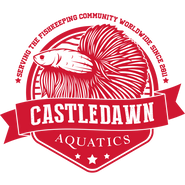Detritus in Blackwater Aquariums: Nature’s Balance Beneath the Surface

In a traditional aquarium, detritus is often seen as something messy to be vacuumed away. Yet in a blackwater aquarium, it is part of the beauty and balance that defines this natural style of fishkeeping. The dark, tea-coloured waters, layered botanicals, and soft bed of decaying leaves create an environment that feels alive, complex, and remarkably self-sustaining.
What Is Detritus?
Detritus refers to the organic material that naturally collects in your aquarium as leaves, seed pods, driftwood, and botanicals begin to soften and break down. In a blackwater aquarium, this detritus is not waste in the traditional sense but rather a living layer that supports a thriving community of microorganisms, bacteria, fungi, and microfauna.
Instead of viewing detritus as a nuisance, it helps to see it as part of the ecosystem you are recreating. In the wild, blackwater rivers and forest streams are filled with decomposing material that feeds countless aquatic species and stabilises the water chemistry.
The Role of Detritus in the Blackwater Ecosystem
1. A Nutrient Burst
As leaves and botanicals decompose, they release trace minerals such as calcium, potassium, magnesium, and phosphorus, along with organic acids and tannins. These compounds are beneficial for aquatic plants and microorganisms, helping to create the soft, mineral-balanced conditions that blackwater species prefer.
While the word “decay” might sound negative, this slow decomposition process provides a continuous, gentle nutrient cycle that keeps the environment naturally balanced.
2. Fuel for Beneficial Bacteria
Detritus is home to beneficial bacteria that are vital to the nitrogen cycle, converting ammonia into nitrite and nitrate. These colonies grow within the detritus itself and along the surfaces of wood and botanicals, acting as a natural biological filter.
Because these bacteria thrive in low-oxygen, organic-rich environments, detritus actually supports the long-term stability of the aquarium rather than compromising it.
3. Habitat for Microfauna
Microscopic crustaceans, worms, and protozoa flourish within the detritus layer. They form an essential part of the food chain, providing a steady source of nutrition for shrimp, small catfish, and fry.
This constant cycle of breaking down, feeding, and regenerating makes detritus one of the most active and important components of a blackwater tank.
4. Natural Filtration and Metal Binding
Detritus can also bind to and neutralise trace metals and toxins that may enter your aquarium through tap water or fish food. This process helps keep the water chemistry stable and reduces potential stress on your fish and plants.
5. The Aesthetic of Nature
Beyond its biological value, detritus adds a unique, organic beauty to the blackwater aquarium. The layered leaf litter and botanicals create the look of a forest stream bed, offering both shelter and comfort to species that naturally inhabit these waters.
Rather than a “dirty” look, detritus brings texture, realism, and calm — transforming your aquarium into a miniature ecosystem that mirrors the wild.
Should You Remove Old Leaves or Replace Them?
It can be tempting to remove decomposing leaves and replace them with fresh ones, especially if you are new to blackwater aquariums. However, doing so interrupts the natural balance you are trying to build.

As botanicals break down, they lose sugars and sap, becoming primarily cellulose and lignin — materials that are stable and largely inert. These softened leaves become the foundation of detritus and are not a source of measurable ammonia when left undisturbed.
Instead of removing them, layer new botanicals over the existing ones. This mimics the natural process in rivers and flooded forests, where fresh leaves fall onto older layers, maintaining both structure and nutrient flow.
Maintaining Detritus in Balance
While detritus is beneficial, balance remains crucial. Too much accumulation can reduce oxygen levels or release excess nutrients if left unmanaged.
Light Siphoning
During water changes, gently siphon only small areas to remove loose debris. Avoid deep substrate cleaning, as this can disturb the bacterial colonies that keep your aquarium healthy.
Moderate Filtration
Use a filtration suited to gentle blackwater flow. Overly aggressive filters can strip the fine organic material from the water and disrupt the ecosystem.
Water Testing
Regularly test ammonia, nitrite, and nitrate levels to ensure the system remains in equilibrium. In a mature, stable blackwater aquarium, readings should remain low, even with visible detritus.
Natural Consumers
Species such as shrimp, snails, Corydoras, and small catfish graze continuously on detritus and biofilm. They help keep the balance naturally without the need for constant human intervention.
The Science Behind It
Research and observation suggest that detritus derived from leaves and seed pods — materials already depleted of sugars and nitrogen — poses no measurable threat to water quality. Instead, it supports an oxygen-regulated bacterial community that helps convert and stabilise organic compounds.
These layers of detritus and biofilm provide a home for anaerobic and aerobic bacteria, which together handle complex nutrient conversions. It is one of the reasons blackwater aquariums often achieve remarkable long-term stability once matured.
Friend or Foe?
Detritus is only a problem when misunderstood. In a well-balanced blackwater aquarium, it is a friend that supports life at every level. Regular maintenance, consistent water changes, and careful feeding ensure that this natural process remains in harmony.
By embracing detritus as part of your aquarium’s identity, you are not just keeping fish — you are cultivating an entire miniature ecosystem that mirrors the beauty of nature.





